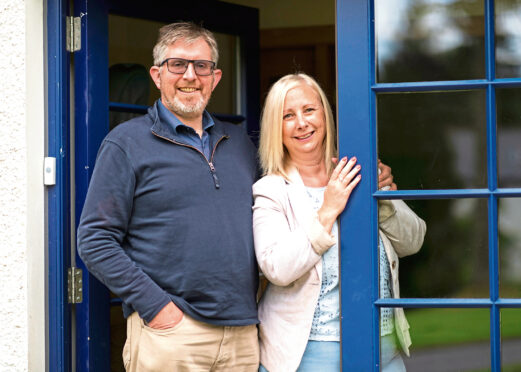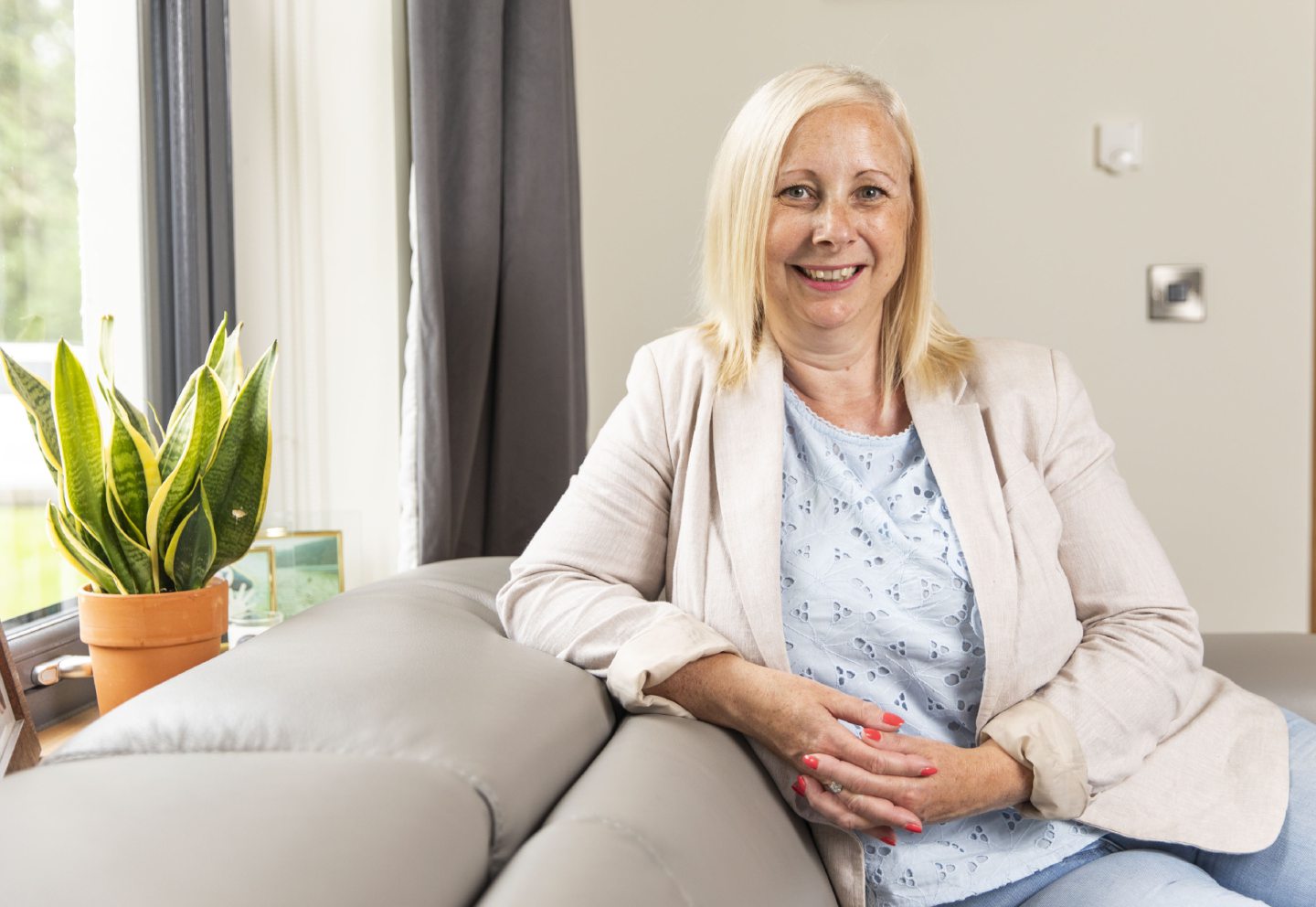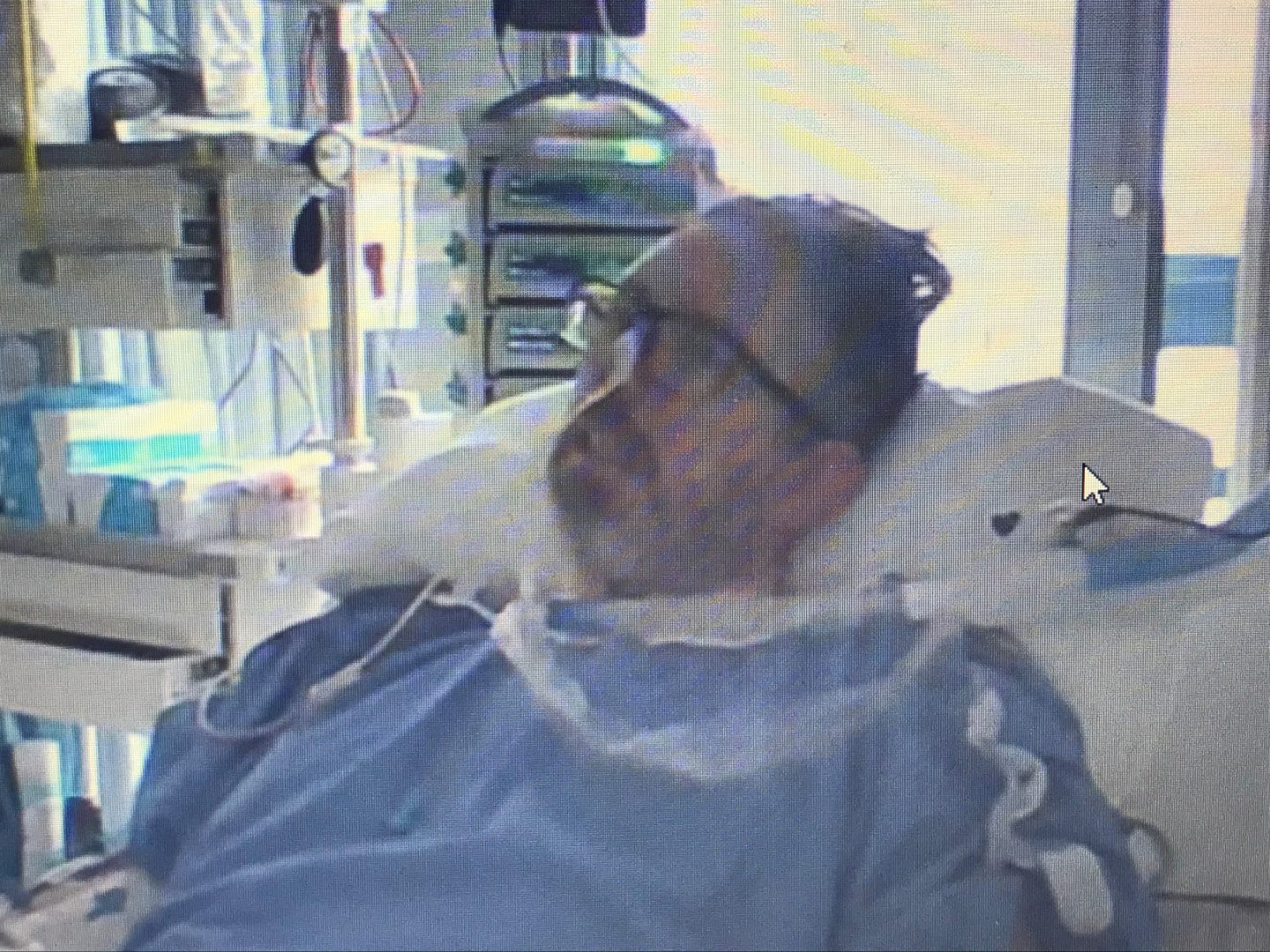
“I am going to die, please save my life.” That was Grant McIntyre to his intensive care team on April 1 last year and, reader, they did.
He knew he was ill but, thankfully, no one perhaps knew just how ill he was to become, as he endured 128 days in hospital, 86 of them in ICU, 50 of them in a medically induced coma.
His battle with Covid saw him dubbed the sickest patient in Scotland but his inspirational endurance and survival story were to inspire a nation reeling from the relentless blows of the pandemic.
In a photograph that went viral before becoming iconic in Scotland’s fight against the virus, he left hospital in an Eat, Sleep, Rehab, Repeat T-shirt, waving happily to the applauding NHS staff who had saved his life.
Walking a few yards behind him, pushing the empty wheelchair he refused to use, wearing a mask hiding the broadest smile, was his wife Amanda and, while her husband’s story has been told many times, what was it like for her, at home, unable to visit, worried, and uncertain? It was, she says today in her first interview, full of hope. It had to be.
Sitting in her Perthshire home surrounded by family photographs, she looked back on those harrowing months and said simply: “I had no choice but to remain strong and keep believing that he would live. Hope was my state of mind and I would only envisage Grant’s survival not death. It was not easy, but I continued to believe he would make it.
“Three times I was told he was dying but refused to accept it and at one point the hospital staff were so worried by my response, they called Grant’s brother to help me realise the gravity of the news.
“However, I did not lose faith in his survival. I never allowed myself to believe there was no hope.”
She remembers her husband beginning to feel fluish and developing a cough. She suspected Covid and worried he might have contracted it through his job as clinical director for the Hospital Dental Service in Tayside.
With his breathing laboured he was admitted to his own hospital, Ninewells in Dundee, only to recover enough to be sent home.
He deteriorated again and was transferred back, toiling for every breath. Again he recovered and returned home only to be readmitted once more, gasping to breathe as the virus played out its hallmark game of hide and seek, making patients improve and then plummet catastrophically. That was the last time Amanda would see Grant for three months.
His brutal illness and arduous, uplifting recovery has now been detailed in Dying to Live: The Remarkable True Story Of Scotland’s Sickest Survivor Of Covid-19, a book written by the couple.
In the weeks leading up to lockdown in March last year the dental chief and his colleagues had watched, fearful, as Covid inched from Asia to Europe and towards Scotland.
They studied the template response for the threat of a swine flu pandemic in 2009 and the contingency plans bore a striking parallel, with tiered restrictions from zero to four.
Like the loved ones of health workers all over Britain, Amanda worried that her husband would catch the virus. She said: “Dire news reports of patient-facing staff dying, and dangerously ill ones lying prone in ICU units were chilling.
“Back then Grant was more worried about protecting colleagues and staff so he worked with colleagues to cease aerosol generating procedures (AGPs) – essentially drilling – as they were worried this would spread this respiratory virus.
“An email from the Scottish Government said that this was a ‘gross overreaction’ which would limit patients’ access to care and so the instruction was to carry on as normal.
“Desperate to protect staff and themselves, they limited access to AGPs as a middle ground.”
However, Grant became ill towards the end of March, lost his sense of smell and felt so rundown he was unable go to work for the first time in 27 years. “He became breathless and thought childhood asthma had returned. We called an ambulance but after being examined he was sent home,” Amanda added.
“A Covid test subsequently proved positive. Two days later he was readmitted with breathlessness and discharged again but he continued to worsen so badly, he had no recollection of being admitted for the third time. We stayed at home as relatives were not allowed into hospital for Covid reasons.”
In hospital, Grant had an out-of-body experience where he saw himself floating above his bed looking down at his inert body. He was transferred to the makeshift high-dependency unit. Once there, two consultants in full PPE approached the bed and said: “Right, we’re ready to go.”
He was anaesthetised and transferred to ICU only to remember nothing until waking up almost two months later.
Amanda said: “At first his ICU team called saying he was doing well with his blood oxygen level increasing and then he crashed. It summoned weeks of hopeful and then dire news.
“I could only remain focused on his survival and dismissed any thought that he would die, no matter how close he came.
“He was to endure a cytokine storm where overwhelming inflammation caused his body to go into overdrive and attack itself. His organs began to fail as the odds stacked heavily against him.
“In a desperate attempt to save him he was transferred to a high-grade ICU called ECMO at Aberdeen Royal Infirmary but continued to deteriorate.”
At his bleakest moment doctors at Aberdeen Royal’s ECMO unit video-called to say: “We don’t think Grant can survive this.”
Amanda was aware that this was their way of preparing her for the worst because they had watched so many Covid patients die despite every possible treatment.
“In a make or break attempt to save him they gave Grant a five-day steroid course which would either improve or overwhelm him with infection and fortunately he improved. My plan to see only survival was working.”
While Grant was fighting to survive, stories began to appear on social media suggesting he was not really ill, that he was being used as a Scottish Government gimmick to scare people to stay distanced and in lockdown.
“Grant was fighting a terrible battle to survive Covid and some people were accusing him of faking it. That was a seriously low point and I felt angry and hurt,” said Amanda.
Meanwhile, in a valiant attempt to keep life as normal as possible Amanda returned to her job as a primary school deputy head, working from home.
“I felt long hours doing nothing but waiting on the hospital to ring would be worse. Surely work would be a good distraction?
“By trying to keep everything else in our lives normal, we would cope. In my head Grant was going to recover, get out of hospital and aim to return to work,” she said. “I am not religious in the conventional sense, but more spiritual, and believe in the power of hope.”
The couple have four children between them and Amanda endeavoured to stay calm to limit their uncertainty and distress.
“I could not afford to be consumed by fear and grief, especially not when I had our children to care for.”
Amanda, 52, was a late entrant to teaching after previously running an IT training business. It is obvious from the pile of school books and drawings on the dining table that she thrives on helping children achieve their potential.
During her husband’s battle in ICU Amanda successfully applied for a job as head teacher. “It was part of my staying positive strategy,” she added.
Meanwhile, Grant was making progress and even able to get out of bed for a few moments. “A wonderful highlight of his 128 days in hospital was his son’s 21st birthday when he managed to blink and lift a finger to wave from his bed.”
Covid had deconditioned his body so much, even these gestures exhausted him but, after long weeks of rehab with medical and support staff Grant was able – still attached to a network of tubes and cables – to meet Amanda.
“It was just for 10 or 15 minutes but it confirmed my belief that he would make it. We had turned the corner of an exhausting and painful journey for us both.”
Months of rehab and physio were followed by a safe return home and eventually last November, back to work, part-time, with orthodontic patients, some of whom are youngsters with cleft lip and palate anomalies.
Determined to properly detail the work of the NHS in Grant’s recovery, their book has been praised by ICU doctors, other survivors and public health experts.
Professor Linda Bauld of Edinburgh University, an expert commentator throughout the pandemic, said: “If you ever doubted how serious a disease Covid-19 is, please read this book.
“This is a personal story but it is also a rallying call for continued and expanded investment in the NHS, public health and disease prevention.”
Today, Grant continues to make a good recovery. He remains on painkillers for nerve damage to his feet, and continues to receive physiotherapy and other rehab.
Amanda is also decompressing after a harrowing year: “It took me a long time to make peace with Covid and I was upset and distressed by pictures of others in the same plight.
“My emotional regulation was erratic and I was distressed by politicians not making the right decisions at the time.
“When I see a politician make a glib remark I think: ‘This is not real for you in the way it has been for tens of thousands of others.’”
How survivor helped his recovery by taking on internet trolls accusing him of being part of ministers’ Covid conspiracy
Anti-lockdown trolls peddling ludicrous conspiracy theorists piled more pain on the McIntyres after claiming Grant’s fight for life was faked.
He said: “Amanda and her daughter saw comments on social media saying they thought I was a sham and that was particularly upsetting after all the worry and anxiety family and friends had been through.
“They reported these to the social media companies and blocked those people to avoid further upset. When I was finally discharged from hospital, I received a huge amount of support from family, friends and people throughout the world.
“This was not the whole story. Some sceptics found my email address online and contacted me through social media making all sorts of accusations.
“They said I was an actor starring in publicity films for the NHS while hospitals were empty and that I was pretending to be ill to frighten people into lockdown. Others asked if I lived near a 5G mast and had contracted Covid due to this.
“Some suggested that I was infected by a parasite that would return until I was ‘cleansed’ or told me that I had received poor treatment and had the doctors treated me with hydroxychloroquine, invermectin or other pharmaceuticals and chemicals – including an Aboriginal tree root derivative – that I would not have been in intensive care.
“Some people said I must be very wealthy to afford the hospital care, and so we presumed many of these people were not from the UK.
“They would tell me I was not really ill or that worse still, the treatment had made me desperately sick – not Covid-19.
“So I spent part of my rehabilitation replying to correct any wrong impressions that Covid was harmless or that treatment was the real problem. I managed to convince some sceptics, but others remained adamant I was faking it.
“Instead of getting angry, I found most of the misguided critics funny. It’s not how you fall that matters but how you get back up again.”

Enjoy the convenience of having The Sunday Post delivered as a digital ePaper straight to your smartphone, tablet or computer.
Subscribe for only £5.49 a month and enjoy all the benefits of the printed paper as a digital replica.
Subscribe © Jamie Williamson
© Jamie Williamson © Jamie Williamson
© Jamie Williamson